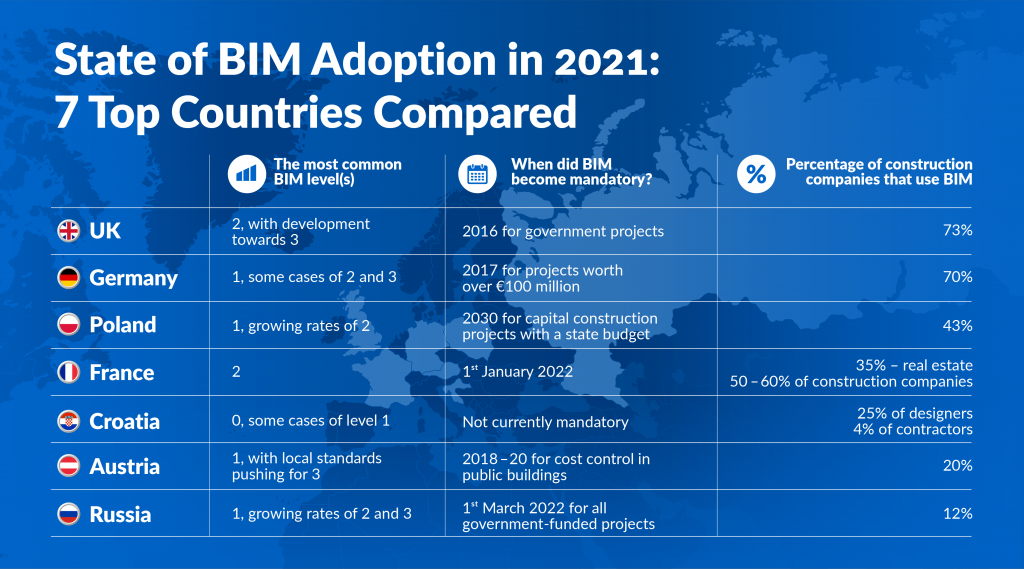The UK still leads the way for European countries implementing BIM, but Germany and Russia are ‘snapping at its heels’, according to research
In 2021, the UK remains the undisputed leader in BIM implementation in construction, compared with other European nations, according to PlanRadar’s latest Europe-wide ranking of BIM adoption.
The company analysed research, examined government policy documents and conducted interviews to discover why BIM is being deployed in each country, and to gauge construction professionals’ attitudes to digital technology tools in their industry.
It also explored where swift growth in BIM is most likely in the coming years, and which governments have progressed furthest in making construction BIM mandatory.
Britain has long been considered a pioneer in BIM technology, with projects such as the Heathrow Airport reconstruction using early BIM technologies in the 1980s.
However, while Russia’s first BIM projects only appeared in 2014, the country is on a steep upward trajectory. No other European country has adopted so many laws on standardisation and the mandatory implementation of BIM in the construction industry.
Similarly, Germany’s highly developed construction market reveals advanced and widespread BIM adoption. The government is investing in BIM standardisation, skills training and support for BIM projects, as part of its vision for the future digitalisation of the German construction sector.

BIM implementation in Europe:
UK
The UK has the highest number of construction companies using BIM at level 2 and beyond. It remains the leader in the earliest use and implementation of BIM in construction projects. Since 2016 all state-funded projects must use at least BIM level 2, and this has led to a surge in awareness and use of BIM in the last decade. For private projects, BIM usage is advised but not mandatory. Currently, only 62% of small businesses in the UK actively use BIM, compared to 80% of large businesses.
Germany
70% of German construction companies use BIM at different levels. However, the majority are architects and design companies. Since 2017, BIM has been mandatory for projects worth over €100m. And from 31 December 2020, BIM became mandatory for all public contracts relating to the building of federal infrastructure.
France
France does not yet have a single BIM standard enshrined in law or regulation, yet 35% of developers in France use BIM for their real estate projects. In addition, 50 to 60% of the leaders in the French construction market have switched to BIM, with level 2 as the most common maturity level. At the end of 2018, BIM Plan 2022 was launched to encourage construction participants to integrate it into their workflows.
Austria
Austria has developed its own advanced BIM standards – ÖNORM A 6241-2 (covering all BIM levels including 3). However, only 20% of small and medium construction companies use BIM. Since 2018, BIM has been mandatory for budget control in the construction of public buildings. In accordance with a recommendation by the European Commission, BIM has been mandatory in Austria for tenders and public works contracts since 2020. However, legislation enforcing the use of BIM in Austria more broadly has not been passed.
Russia
BIM technology is used by very large property developers and construction companies that operate in the largest cities such as Moscow, St. Petersburg, Kazan, Ufa, Yekaterinburg. When it comes to legislation standardising and mandating BIM, Russia is the clear leader. Today there are 15 national standards (GOSTs) and eight sets of rules for information modelling in the country. From March 2022, all government projects are required to use BIM technology, and further legislation is in the pipeline.
Poland
Research from 2019 found that 43% of developers used BIM, however the BIM protocol in Poland is not standardised. Polish laws to regulate the use of BIM have stumbled in recent years. In 2020, The Ministry of Development, Labour and Technology published a roadmap of BIM implementation for public procurement. However, it’s thought BIM won’t become mandatory in Poland for capital construction projects with a state budget until 2030.
Croatia
The lowest-ranked in terms of BIM implementation at the state level is Croatia. Approximately 25% of all Croatian architects and designers use entry-level BIM, meaning level 0, or two-dimensional CAD projects. BIM does not currently feature in Croatian building legislation.
















